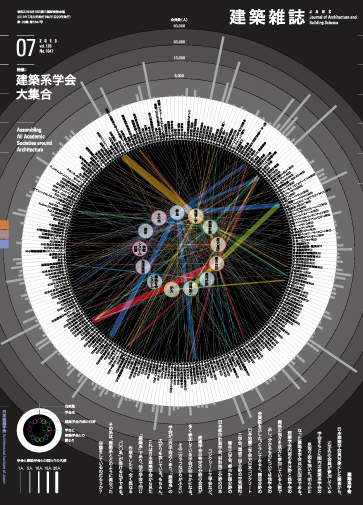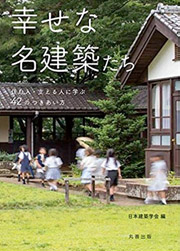本文PDFの閲覧につきましては、こちらでご確認ください。

2013-7月号 JULY
特集= 建築系学会大集合
Assembling All Academic Societies around Architecture
特集前言 ジャングルの地図を描く:建築系学会の生態系を見直すために
世に「学会」は数多ある。
では、建築に関連する「学会」群の広がりは今どのような様相を呈しているのだろうか。
本会の会員諸氏も、一人ひとりの視野には、関心のある学会群の「小集合」が、それなりにまとまった庭のような風景をなして見えているだろう。しかし、全体としての建築系学会群の「大集合」は、すでに輪郭も見えないジャングルなのではないか。無数とも思える建築関連学会が林立し、会員の活動圏は複雑に重なり合っている。
そもそも本会の前身「造家学会」も、1886(明治19)年に「工学会」(現・日本工学会、1879年創立)から「分離」するかたちで始まった。その後、特に戦後に多数の学会が創立されたと思われるが、しかし、大小多様な学会の相次ぐ創立という状況は、長い歴史のなかではかなり近年の動向に属すのではないか。言うまでもなく、学会の輪郭を決める専門領域の固有性や統合性は、その背景にある市場・社会・政治との関係、そして、教育の体制(教育者・研究者の再生産を含む)とかかわっているが、それらは時代とともにダイナミックに変わっていくものだろう。その意味で、近年の動向はこうした構造全体の揺らぎを反映している。
考えてみれば、会員3万5千人ほどを擁する日本建築学会のようなマンモス学会は、そのスケールや総合性に依拠した特性を備えており、それぞれに異なる性質を持った他の多くの関連学会と共に、大きな生態系をなしているのだとも言えるだろう。それは一定の妥当性を持って機能していると同時に、さまざまな閉塞となんらかの再編に向かうダイナミズムを潜在させているに違いない。
本特集は、こうした、相当にエントロピーの増大した今日の「建築系学会」の生態系を可視化する試みである。この状況をどう活用し、また、どう反省して今後を描くか。そのための羅針盤をつくれないかと考えた。
しかし、ジャングルの地図を描くことは容易ではない。それなりの方法、例えば、統計的な方法が必要ではないか。そこで、会誌編集委員会では、2013年2月から3月にかけて会員へのウェブ・アンケートを行った(電子メールを使わない会員のためには、雑誌上に告知を出し、他の方法で回答できるようにした)。会員諸氏のご協力により、500を超える回答を得ることができた。また、併せて各分野を代表する会員諸氏に依頼し、記名での回答も募った。
編集委員会で集計したところ、本会の会員が参加している300ほどの国内学会・国際学会が明らかになった。また、学会一般に対してどのような意義を認めているか、どのような問題を感じているかも尋ねた。これらの結果は、第2部「日本建築学会員から見た学会界」において、いくつかの方法で整理している。また、そのうち会員諸氏が参加している国内学会については、表紙のグラフィックにまとめた。各学会の規模、本会と双方に参加している会員数などを図化することで、建築系学会の生態系の広がりと、リンケージの量的強弱を可視化している。第3部「建築系学会総覧」では、アンケートの回答で会員諸氏が推薦してくださったなかから40ほどの学会を取り上げ、当該学会に依頼して提供いただいた基礎情報を紹介した。
こうしてそれなりに可視化された建築系学会の集合図をどう読むかは、第1部および第4部の対談から学ぶことができる。第1部は、学問の動的な生態系を研究対象とする福島真人氏と、自ら新しい学的運動を展開してきた村松伸氏との対談である。学会という場がどのような論理で生まれ、硬直化し、組み変わっていくかが縦横に議論されている。第4部では、企業組織における知識創造を研究してきた紺野登氏と、建築構法計画という横断的・総合的な分野を専門とする南一誠氏に、建築系の諸学会および日本建築学会の今後について展望していただいた。組織と社会の関係をメタレベルから再検討する視点、長期の歴史的パースペクティブ、個人と組織の関係など、示唆に富む論点が散りばめられている。
会誌編集委員会
本号編集担当:饗庭伸(首都大学東京)・竹内泰(宮城大学)・蜷川利彦(九州大学)
[目次]
| 000 | 連載 再建への意志:図面のなかの都市復興 ファイアー・ウォールとなった防火建築帯─秋田県大館市/角哲 |
| 002 | 連載 東日本大震災|連続ルポ1|動き出す被災地 復興支援員制度の一年目/石塚直樹 |
| 004 | 連載 東日本大震災|連続ルポ2|仮すまいの姿 仮設住宅試行─フクシマトクシマの会/内野輝明 |
特集 建築系学会大集合
| 006 | 特集前言 ジャングルの地図を描く─建築系学会の生態系を見直すために |
第1部 学会の生態系
| 008 | 対談 福島真人 × 村松伸 |
第2部 日本建築学会会員から見た学会界
| 014 | 日本建築学会会員から見た学会界/会誌編集委員会 |
第3部 建築系学会総覧
| 019 | 1. 一般社団法人 エネルギー・資源学会 2. 形の科学会 3. 公益社団法人 空気調和・衛生工学会 4. 建築史学会 5. 一般社団法人 建築鉄骨構造技術支援協会 |
| 020 | 6. 一般社団法人 交通工学研究会 7. 国際なかなか遺産推進委員会 8. 骨材資源工学会 9. 公益社団法人 こども環境学会 10. 公益社団法人 地盤工学会 11. 棚田学会 |
| 021 | 12. 多摩ニュータウン学会 13. 地中海学会 14. DOCOMOMO Japan 15. 公益社団法人 土木学会 16. 一般社団法人 日本医療福祉建築協会 17. 日本インテリア学会 |
| 022 | 18. 日本LCA学会 19. 一般社団法人 日本音響学会 20. 公益社団法人 日本火災学会 21. 一般社団法人 日本家政学会 22. 一般社団法人 日本風工学会 |
| 023 | 23. 一般社団法人 日本機械学会 24. 一般社団法人 日本教育学会 25. 一般社団法人 日本建築構造技術者協会 26. 日本建築仕上学会 27. 日本公衆衛生学会 |
| 024 | 28. 公益社団法人 日本コンクリート工学会 29. 日本災害復興学会 30. 公益社団法人 日本材料学会 31. 公益社団法人 日本地震工学会 32. 日本図学会 33. 日本生活学会 |
| 025 | 34. 公益社団法人 日本地理学会 35. 公益社団法人 日本都市計画学会 36. 日本ヒートアイランド学会 37. 日本民俗建築学会 |
| 026 | 38. 一般社団法人 日本木材学会 39. 農村計画学会 40. 文化資源学会 41. mAAN(アジア近代建築ネットワーク) |
第4部 学会の自己組織化
| 027 | 対談 紺野登 × 南一誠 |
| 031 | 編集後記 饗庭伸 |
| 031 | 次号予告 2013年8月号|特集:アジアン・ハウジング・ナウ |
| 032 | 特集を読んで 2013年5月号|特集:建築評価の現在形:脱中心化・断片化・ローコンテクスト化する言説環境とそのゆくえ 何に向けての批評性か/河野裕 評価の基盤とは?/米田明 |
| 033 | 連載 建築の争点 歴史的建造物の安全対策、このままでよいのか?/大橋竜太 |
| 034 | 連載 ケンチク脳の育て方 街区の再生─歴史的建造物をめぐる教育プログラム/土本俊和 |
| 035 | 連載 ケンチク脳の活かし方 建築パースから絵本へ─手を動かして絵を描き続ける/青山邦彦 |
| 036 | 連載 地域いろいろ・多様な日本 民活刑務所を誘致したかつての炭鉱町/山本薫子 |
| 037 | 2013年日本建築学会役員 |
| 041 | 2013年度日本建築学会大会 |
Preface to the Special Issue: Drawing a Map of a Jungle: Reassessing the Ecosystem of Academic Societies around Architecture
There are so many academic societies in the world.
Right, then what phase is the extent of the group of architecture-related academic societies entering now?
All AIJ members, according to their individual interests, might see a small assembly of the group of academic societies as a view of a garden well-arranged in its own way. But a big assembly of the total group of academic societies around architecture is already a jungle of invisible outline, isn't it? Countless architecture-related academic societies have sprung up, and the members' activity ranges overlap complexly.
At first, Zoukagakkai, AIJ's antecedent, started in 1886 (Meiji 19) by separating from Kougakukai (currently the Japan Federation of Engineering Societies, established in 1879). Then, especially after the war, it would seem that many academic societies were established, but the circumstances surrounding the successive establishment of big, small, and varied academic societies belong to a very recent trend in a long history, don't they? Needless to say, the peculiarity and unity of a special field determine an academic society's outlines and are concerned with background relations between markets and society and politics, and with educational systems, including the reproduction of educators and scholars, all of which would change dynamically with the times. In that sense, the recent trend reflects tremors in the whole structure.
Come to think of it, we could also say that a mammoth academic society such as AIJ, with some 35,000 members, has a peculiarity based on its scale and synthesis, and forms a big ecosystem with many other related academic societies, each with different qualities. That ecosystem functions with uniform propriety while at the same time it surely must harbor latent dynamism that tends toward various blockages and some reorganization.
This feature, then, is an effort to make visible today's ecosystem of academic societies around architecture whose entropy so considerably increased. How can we use the circumstances and reflect them in drawing the future? We wonder if we can make a compass for it.
But it's not easy to map a jungle; it might require a special method such as statistical techniques. So the editorial board sent a web-questionnaire to members from February to March 2013 and put a notice in the journal for members who don't use e-mail and let them respond in other ways. Thanks to good member cooperation, we got more than 500 responses. At the same time, we asked representatives of each field and collected signed replies.
A tally by the editorial board showed that there are about 300 domestic and international academic societies that AIJ members participate in. And members were asked what significance they recognize and what kinds of problems they feel concerning academic societies in general. The results are organized several ways in part 2, "The World of Academic Societies from the Viewpoint of AIJ Members." And the domestic academic societies that the members participate in are gathered in the cover's graphics. Diagramming the size of each academic society, the number of members who participate in both AIJ and others, and so on makes visible the expanse of the ecosystem of academic societies around architecture and the linkages' quantitative strengths and weaknesses. In part 3, "A Conspectus of Academic Societies around Architecture," we pick up about forty academic societies from those recommended by members in questionnaire answers and introduce the basic information that they offered.
The talks in part 1 and part 2 help in learning to read the collected diagrams of academic societies around architecture that are made visible in this way. Part 1 is a talk by Masato Fukushima, whose subject is the dynamic ecosystem of learning, and by Shin Muramatsu, who has developed a new scholarly movement himself. They freely discuss how academic societies are born from a kind of logic, grow stiff, and undergo change. In part 4, Noboru Konno, who has studied knowledge creation in business organizations, and Kazunobu Minami, an expert in the cross-sectional and total field called the planning of building construction, survey the future of AIJ and all academic societies around architecture. Suggestive contentions such as viewpoints that reconsider the relations between organizations and society from the metalevel, the long-historic perspective, the relations between individuals and society, and so on are scattered.
Editorial Board
This issue has been edited by Shin Aiba (Tokyo Metropolitan University), Yasushi Takeuchi (Miyagi University) and Toshihiko Ninakawa (Kyushu University).
[Contents]
| 000 | [Series] The Resolve to Rebuilding: City Reconstruction in Blueprint A Fire-Preventive Building Zone That Became a Fire Wall─ Odate Akita / Satoru Kaku |
| 002 | [Series] Great East Japan Earthquake Serial Report 1 Devastated Areas Have Just Started to Stir The First Year of a Recovery-Supporter System / Naoki Ishizuka |
| 004 | [Series] Great East Japan Earthquake Serial Report 2 Life in Temporary Housing Temporary-Housing Trial─Fukushima-Tokushima no Kai / Teruaki Uchino |
Special Feature
Assembling All Academic Societies around Architecture
| 006 | [Preface to the Special Issue] Drawing a Map of a Jungle─Reassessing the Ecosystem of Academic Societies around Architecture |
Part1 An Ecosystem of Academic Societies
| 008 | [Dialogue] Masato Fukushima × Shin Muramatsu |
Part2 The World of Academic Societies from the Viewpoint of AIJ Members
| 014 | The World of Academic Societies from the Viewpoint of AIJ Members / Editorial Board |
Part3 A Conspectus of Academic Societies around Architecture
| 019 | 1. Japan Society of Energy and Resources 2. Society for Science on Form, Japan 3. The Society of Heating, Air-Conditioning and Sanitary Engineers of Japan 4. Society of Architectural Historians of Japan 5. Supporting Association for Building Steel Structural Technology |
| 020 | 6. Japan Society of Traffic Engineers 7. The Committee for the Promotion of "Naka-naka" Heritage Site 8. Japan Institute of Aggregate Technology 9. Association for Children's Environment 10. The Japanese Geotechnical Society 11. Rice Terrace Research Association |
| 021 | 12. Tama New Town Society 13. Collegium Mediterranistarum 14. DOCOMOMO Japan 15. Japan Society of Civil Engineers 16. Japan Institute of Healthcare Architecture 17. Japan Society for Interior Studies |
| 022 | 18. The Institute of Life Cycle Assessment, Japan 19. The Acoustical Society of Japan 20. Japan Association for Fire Science and Engineering 21. The Japan Society of Home Economics 22. Japan Association for Wind Engineering |
| 023 | 23. The Japan Society of Mechanical Engineers 24. Japanese Educational Research Association 25. Japan Structural Consultants Association 26. Japan Society for Finishing Technology 27. Japanese Society of Public Health |
| 024 | 28. Japan Concrete Institute 29. Japan Society for Disaster Recovery and Revitalization 30. The Society of Materials Science, Japan 31. Japan Association for Earthquake Engineering 32. Japan Society for Graphic Science 33. Japan Society of Lifology |
| 025 | 34. The Association of Japanese Geographers 35. The City Planning Institute of Japan 36. Heat Island Institute International 37. The Japan Society for Folk Architecture |
| 026 | 38. The Japan Wood Research Society 39. The Association of Rural Planning 40. The Association for the Study of Cultural Resources 41. mAAN |
Part4 The Self-Organizing of Academic Societies
| 027 | [Dialogue] Noboru Konno × Kazunobu Minami |
| 031 | [Editor's Postscripts] Shin Aiba |
| 031 | [Previews of Coming Issues] 2013, August|Asian Housing Now |
| 032 | [Reviews of Previous Issue] 2013, May|Evaluating Architectural Designs: Prospects for a Decentralized, Segmented, and Low-Context Discourse Environment What is the criticism for? / Hiroshi Kohno What Is the Basis of Evaluation? / Akira Yoneda |
| 033 | [Series] Issues in Architecture Is It Unquestionable for the Current Safety Measure on Historic Buildings? / Ryuta Ohashi |
| 034 | [Series] Cultivating Versatile Architects The Reclamation of Blocks─Education Programs Concerning Historic Buildings / Toshikazu Tsuchimoto |
| 035 | [Series] Architects Branch Out From Architectural Perspective to Picture Books─Keep Drawing and Moving the Hand / Kunihiko Aoyama |
| 036 | [Series] Local Identities: Diverse Japan A Former Coal Mine Town That Attracted a Private-Finance-Initiative Prison / Kahoruko Yamamoto |
| 037 | AIJ Officers 2013 |
| 041 | AIJ Annual Convention 2013 |




 『幸せな名建築たち 住む人・支える人に学ぶ42のつきあい方』
『幸せな名建築たち 住む人・支える人に学ぶ42のつきあい方』





